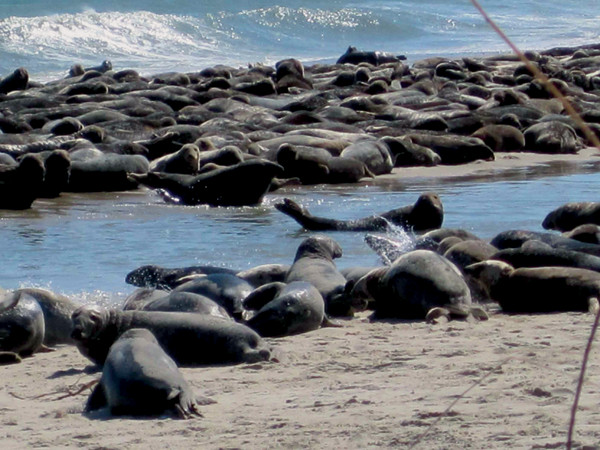
by Harvey Leifert Monday, June 23, 2014

Researchers have found new pathogens in gray seal populations. Credit: U.S. Fish and Wildlife Service.
The spread of pathogens into new areas is a pressing issue, according to Michael Grigg, a molecular parasitologist with the National Institutes of Health in Bethesda, Md. He reported on his research at the annual meeting of the American Association for the Advancement of Science (AAAS) in Chicago in February.
Ice is a major eco-barrier for pathogens, but with Arctic ice diminishing rapidly amid the changing climate, pathogens have an opportunity to move into new areas and spread disease, Grigg noted. Marine mammals, hosts for pathogens, are spreading their range and intermingling as never before. At the AAAS meeting, he discussed two particular parasites, one found for the first time in the Arctic and one for the first time south of the Arctic.
Toxoplasma gondii affects humans and all warm-blooded vertebrates. Classed as a eukaryotic protozoan parasite, it typically finds a home in the brain and spinal fluid, but is not a major concern in healthy individuals. In susceptible individuals, however, it can cause encephalitis, an inflammation in the brain, or blindness if the parasite takes hold in the eyes. Toxoplasma is also an “AIDS-defining organism,” Grigg reported, meaning that its presence in persons who are HIV positive leads to a diagnosis of AIDS. Toxoplasmosis caused by the pathogen can also be fatal, particularly to human fetuses; because the pathogen is excreted in the feces of infected individuals of all feline species, pregnant women are routinely warned not to clean cat litter boxes.
Although common in the lower 48 states, Toxoplasma has for the first time been observed in western Arctic beluga, a whale species inhabiting the Beaufort Sea, Grigg said. The significance of the discovery is that belugas are harvested by Inuit hunters as a mainstay of their traditional diet. As a result, he said, public health warnings have been issued to local populations that whale meat must be well cooked or air dried before either human and feline consumption.
The most likely reason for Toxoplasma’s arrival in the Arctic is that as the Arctic has warmed, lynx populations have moved farther north, bringing the parasite with them, Grigg told EARTH. In addition, there appear to be more domestic and feral cats living in Inuit communities than in the past, although this has not been studied and documented, he says. A lynx or domestic cat can excrete 100 million oocysts, hardy spore-like structures that contain and can transfer the pathogen, over just a week or two, Grigg says. Just one oocyst can infect a mammal.
Oocysts can only be killed by freezing, boiling or drying them out. And with the Arctic warming, periods during which the organisms can remain viable are getting longer, Grigg told EARTH, just as more are introduced into the environment through larger lynx and feline pet populations in the area.
The mechanism by which belugas become infected with Toxoplasma has not been established, according to Grigg. “We did not expect to see this parasite in marine mammals that do not eat other mammals and never come ashore,” he told EARTH. The simplest explanation, he suggests, would be that feline wastes reach offshore waters, where the pathogens are ingested by fish that the belugas eat.
The geographic movement of pathogens is a two-way street, however, Grigg reported at AAAS, noting the first documented case of an endemic Arctic parasite moving southward. A newly found strain of protozoan, Sarcocystis pinnipedi, was responsible for the death of 406 young gray seals in the North Atlantic in 2012. It also killed a Steller sea lion in Alaska (2004), walruses, Hawaiian monk seals (in 2010 and 2011), and polar and grizzly bears in subarctic Alaska.
North Atlantic gray seals are particularly susceptible to the new disease. They are now able to chase their fish prey farther north into Arctic waters and are mixing with local ringed seal populations, likely the main host species for the Sarcocystis pathogen. The ringed seals have a longstanding, stable relationship with Sarcocystis and enjoy a “herd immunity,” while the newly arrived gray seals are susceptible to infection, Grigg said. The mechanism by which ringed seals pass the pathogen to gray seals has not been determined, he told EARTH.
“Disease has shaped evolution through the ages,” Grigg says. “History has told us that when pathogens emerge into new sites where they have a susceptible population [to infect], they can cause mass mortality events.” The question, he adds, is whether this is “the tip of an iceberg,” and “will we continue to see more mortality events as we see marine mammals from the subarctic moving into these colder waters?”
© 2008-2021. All rights reserved. Any copying, redistribution or retransmission of any of the contents of this service without the expressed written permission of the American Geosciences Institute is expressly prohibited. Click here for all copyright requests.